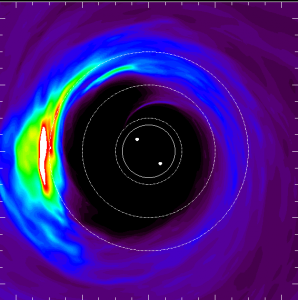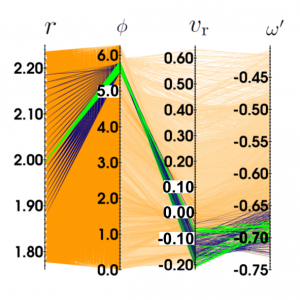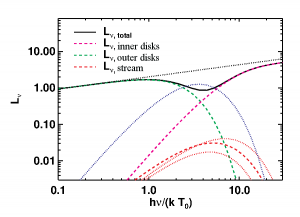Circumbinary Disks
Various types of astronomical binary systems can be embedded  in gaseous disks, from young binary stars to stars with growing planets to supermassive binary black holes (SMBBHs) in merging galaxies. Such disks have been observed directly in nearby star-forming regions and indirectly in galaxy mergers via their time dependent light signals. Its significance also shows up in detecting the gravitational wave (GW) radiation, as the electron-magnetic radiation from the gas disk would help locate the progenitors of GW radiation.
in gaseous disks, from young binary stars to stars with growing planets to supermassive binary black holes (SMBBHs) in merging galaxies. Such disks have been observed directly in nearby star-forming regions and indirectly in galaxy mergers via their time dependent light signals. Its significance also shows up in detecting the gravitational wave (GW) radiation, as the electron-magnetic radiation from the gas disk would help locate the progenitors of GW radiation.
We performed the first 3D MHD simulation of the circumbinary disk (of equal mass binary; paper link at ADS & astro-ph) to study in details how the mass and angular momentum is redistributed by the gravity of the binary. We discovered overdensity lump along with other interesting signatures, such as low density gap, overdensity ‘lump’ near the gap edge (see top left image) , narrow laminar gas streams across the gap (see the top right movie) and disk eccentricity growth. The ‘lump’ also modulates the disk accretion at the local orbital frequency, which provides a possible way to detect binary black hole mergers based on the periodicity.
The big accretion rate found in our previous work let us consider the accretion efficiency problem of a binary. Recently, we ran 3d MHD simulations for disks around single and binary objects. We then measure, to what extent, the accretion rates are affected by the binary torque with respect to the single mass case. We find the circumbinary disks have comparable rate of accretion as the single mass disk does (see different colored lines on the right). We find equilibrium accretion is
let us consider the accretion efficiency problem of a binary. Recently, we ran 3d MHD simulations for disks around single and binary objects. We then measure, to what extent, the accretion rates are affected by the binary torque with respect to the single mass case. We find the circumbinary disks have comparable rate of accretion as the single mass disk does (see different colored lines on the right). We find equilibrium accretion is

achieved and maintained via narrow gas stream with fast inflow speed, which is well explained by the small subset of gas trajectories traveling from the inner edge of the disk to the binary. As illustrated on the left in the parallel coordinates plot, the fluid elements within a ring at the gap edge of the circumbinary disk are represented with orange color lines threading their instantaneous location in position-velocity phase space. Only a tiny fraction of the total, which are colored in blue/green, falls onto the binary. (paper link at ADS & astro-ph).
Better understanding the dynamics and  accretion history of circumbinary disks would provide guidance for future observations as well. For instance, the nearly empty cavity (radius of a few binary separations) carved out of the disk reduces the thermal emission and leaves a ‘notch’ in its thermal spectrum (as shown in the figure on the right). The weak laminar shocks of the gas streams (red curves) are insufficient to mask the energy deficit as we proved recently using our MHD simulation data (paper link at ADS & astro-ph).
accretion history of circumbinary disks would provide guidance for future observations as well. For instance, the nearly empty cavity (radius of a few binary separations) carved out of the disk reduces the thermal emission and leaves a ‘notch’ in its thermal spectrum (as shown in the figure on the right). The weak laminar shocks of the gas streams (red curves) are insufficient to mask the energy deficit as we proved recently using our MHD simulation data (paper link at ADS & astro-ph).
For circumbinary disks formed during either star formation or galaxy merging, there is no compelling reason to assume that the binary orbit should be aligned with the disk rotation initially. There are also growing observations indicate they are not always coplanar. Studying how tilted disks interact with the binary could shed lights on understanding problems such as how does the massive binary black hole merge, and explain observations such as the spin-orbit misalignment between the stars and planets. Currently, I am modeling such tilted circumbinary disks with 3D viscous hydro grid-based simulations using Athena++. The focus here is to study the dynamics of the accretion flows and the angular momentum transport of the binary-disk system when disk is inclined to the central binary.